#Ethnicity estimate
Explore tagged Tumblr posts
Text

So, ancestry.com updated my DNA test. Here is my more precise ethnicity estimate.
#jeremy thompson#ancestry#ancestry dna#ancestry dna results#dna test#ethnicity#ethnicity estimate#Viking blood
0 notes
Text
AncestryDNA is a service that provides genetic testing to help individuals learn more about their ancestry and ethnicity. The AncestryDNA test kit is a simple, non-invasive kit that can be used at home to collect a DNA sample using a saliva sample. The kit is then sent to a lab for analysis, and the results are made available online to the individual who took the test. The results provide an estimate of the individual's ethnic and geographic origins, allowing them to learn more about their ancestry and family history.
#AncestryDNA#Genetic testing#Ethnicity estimate#Family history#DNA analysis#Saliva sample#Genealogy#Ancestry#Ethnic origins#Genetic ancestry testing
0 notes
Text
everything possible ever happened in my dream last night
#vampires. molotov cocktails. discussions about how race and ethnicity are socially constructed. orville peck candle and water bottle.#the water bottle has a cowboy hat top. my brother deadnamed me to a girl on a train. the difficulty in trying to estimate sex and ethnicity#based off skeletons and how shovel-shaped incisors are more common amongst native folks from america and canada and parts of northwest#central and east asia. museum robbery but if the bag touches the ground you explode. so the vampires needed to make a bridge of corpses#strange creature wearing jingle bells because this was also all taking place in european town during christmas#there was so much more i’m not kidding when i say everything happened ever in the span of maybe 20 minutes#my assistant manager was there we had to mop too
8 notes
·
View notes
Text
like comedians, I think a lot of Egyptians would say less evil shit if they got smacked for it more often and knew that was on the table
#cipher talk#'No Black people in ancient Egypt!!!! Bc state records were xenophobic!!!'#State records from WHICH ERAS dumbfuck. Also: state records designed to project a specific political image... ie propaganda?#Meanwhile I have records of multiple ethnic groups. That are what we'd calm Black today. Living and working in Egypt#Ntm all these various Asian ethnic groups that existed within Ancient Egypt and Late Antique Egypt#We got pre-Muslim Arabs. We got Tamils. We got Sinhala. We got Jews. We got Canaanites.#It really pisses me off because these people are nationalistic very patriotic and proud of their idea of Ancient Egypt#They want it to be a prosperous series if kingdoms that influenced everyone but cannot understand: prosperous nations. Have immigrants#Purely because prosperity education medicine religion etc attract people that want a piece! They want to trade! They want to learn!#And Egypt has been prosperous SPECIFICALLY BECAUSE ITS THE CONNECTION BETWEEN TWO CONTINENTS#Which means people from both continents travel through there and settle there. And I either of these continents is... mostly Black people.#Egypt has never been monoethnic and never will be. Die about it.#Modern Egypt is xenophobic and specifically antiblack and there's still millions of Black people there just. Because of the Nubian pop#(Iirc estimated at 2.5 million at the highest. This does not include any other Sudanese groups or other Black Africans)
11 notes
·
View notes
Text

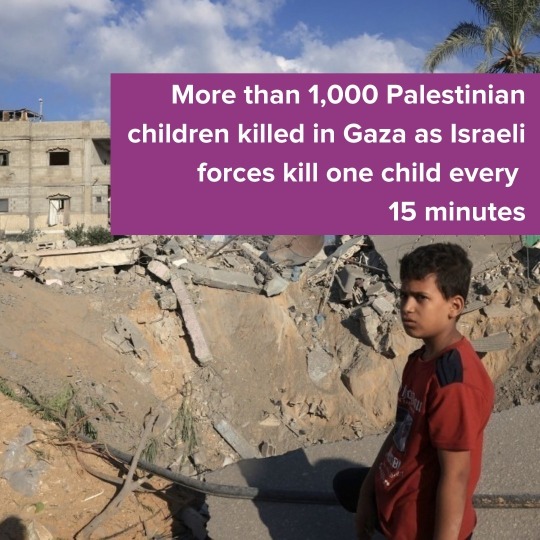
#it's estimated more since many bodies are under destroyed buildings#Palestine#Palestinians#Gaza#Israel#apartheid#genocide#ethnic cleansing#cw death#cw violence#tw death#ifd#war crimes#free palestine
6 notes
·
View notes
Text

FINE, you get another go at the time machine and the ability to prevent one birth (or commit a murder up to you), don't worry about the butterfly effect, we want the butterfly effect that's part of the point. Your actions will prevent them from ever rising to prominence. Original poll here There may be a face off poll at the end. Hitler still isn't an option because we'd all chose to kill him.
Am gonna go Pontius Pilate and say my hands are cleaned of this one. All of the below are nominees.
#So Hitler’s not an option so I propose Cromwell (prepare for a history nerd rant a bit)#not for that banning Christmas stuff or because I like the monarchy#But because he successfully ‘cleared’ huge parts of Ireland of the native Irish to make room for colonisers (just look at the map)#and yes this involved massacres and what would now be considered war crimes#It was attempted ethnic cleansing and had a huge impact for the rest of our history#Drogheda was an example of one of larger massacres of mostly civilians#I feel like a lot of the historical awareness in relation to him (particularly in England) focuses on his role in parliament#This tends to go forgotten when it really shouldn’t#It’s estimated he killed somewhere between 200000 and 600000 in a population of 2 million#And shipped 50000 abroad as indentured servants (NOT as slaves#the indenture expired and did not include children for one thing)#Cannot emphasise the slave/indenture difference enough. Neither were right or moral but it’s on very different scales and can’t be equated
3K notes
·
View notes
Text
this will be a bit of a long post but i ask that you please please read the full thing if you want to know more about Sudan- i feel like not enough people ACTUALLY know what's going on in Sudan. a lot of people have a vague idea that a 'war' and genocide is going on, but it's important to know the specifics as well.
there is extremely little coverage of Sudan from non-Sudanese sources, and even those that DO cover it often paint it as a war between two different generals for power over a country- and to a certain extent, without context, that IS what's happening. for those unaware, the two 'warring factions' in Sudan are the official Sudanese military- the SAF (Sudanese Armed Forces) and the RSF (Rapid Support Forces).
in April 2019, during the Sudanese Revolution, Islamist dictator Omar al-Bashir was deposed by the SAF in response to a mass wave of revolutionary organizing, protests, and sit-ins. Immediately after, the TMC (Transitionary Military Council) was established, with SAF general inspector Abdel Fattah al-Burhan being appointed as the chairman. for a brief time, protestors engaged in negotiations with Burhan, and many believed that he was being ernest in his promises of a true civilian democratic government- but it soon became clear to protestors that he was not actually taking their demands seriously, so demonstrations once again intensified. on June 3, 2019, it was under Burhan's command that the Khartoum Massacre was committed, killing 118 protestors while they were participating in a sit-in at the military headquarters in Khartoum.
as the next few months went by, agreements came about to dissolve the TMC and form a Transitional Sovereignty Council based on a draft of a constitutional declaration. it was supposed to be that a military official would be the chairman for 21 months, then transitioning to a civilian chairman for the next 18 months- but Burhan staged a coup in October of 2021, and dissolved the council and effectively turned the Sudanese government back into a military junta, which was the cause of further protesting.
i want to emphasize the crimes and horrors of the SAF because they are often forgotten in these discussions due to the absolute atrocities committed by the RSF. there is no good guy here- both the SAF and the RSF are vying for dictatorial power. so let's talk about the RSF.
headed by genocidal war criminal Mohamed Hamdan Dagalo, known more widely as "Hemedti", the RSF formed around 2014 due to reorginization of the Janjaweed militias- which were the militias that formed across the Darfuri regions of southwestern Sudan to suppress demonstrations against Bashir's oppressive and racist regime which carried out the first genocide of Massalit and other ethnically non-Arab peoples across Darfur in the early 2000s. so to be succinct- the RSF has direct roots in dictatorial suppression of Sudanis protesting against ethnic cleansing, genocide, and oppression.
for around a decade, the RSF and SAF were different factions of the Sudanese military- both have their roots and a pattern of supporting dictatorial violence and anti-Black genocide. and, on April 15, 2023, these two dictatorial Arab-colonialist powers began fighting out of the blue. fighting has been most intense around Khartoum, the central state and capital city of Sudan, where now an estimated 35% of its residents have been forced to flee, with the rest trapped in the middle of an active war zone.
the RSF has been actively continuing the genocide of non-Arab Darfuri Sudanis that its predecessor the Janjaweed committed 20 years prior. they have been consistently launching attacks against Massalit villages in Darfur and El Geneina. Recently, they have completely ethnically cleansed several Massalit villages, killing hundreds in each one of them. in addition, they are committing so many other war crimes, like sexual violence, blocking access to humanitarian aid, occupying civilian homes and kicking the residents out, along with blatant ethnic cleansing campaigns, mass murder, and targeting of civilians.
but don't think that this is a 'civil war' as many are calling it. a civil war is an internal dispute, but this is far from that. both the SAF and the RSF are supported by external powers, namely the UAE, Saudi Arabia, and Russia, who all provide funding to these groups IN EXCHANGE FOR SUDANESE RESOURCES LIKE GOLD AND OIL. this is, ultimately, not just some random war between two different military groups- it is a war funded by and for foreign colonial powers who have a vested interest in colonizing Sudan for its resources. as an example- the UAE's- and especially Dubai's- infamous gold and jewelry industry, is only made possible by the fact that the UAE illegally smuggles 80% of Sudan's gold- they fund this by sending weapons AND SOLDIERS to the RSF. Several of the gold mines in Sudan are owned and operated by the Russian government.
all of this, both the 'internal' AND the external, colonial aspects of this war and genocide, has led to the world's current WORST humanitarian crisis. not only do LOW estimates place the total murdered in the past year at 150,000, but out of Sudan's population of nearly 47 million, over half (25 million) are in severe need of humanitarian aid, and of those 25 million, over half are children. fighting between the RSF and SAF has lead to severe blockage of aid, and the UN's initial proposed budget of $1.5 billion in April of 2023 has not only not increased to accommodate the severe worsening of the crisis, but ALSO has not even been funded 20%.
2.5 MILLION PEOPLE ARE EXPECTED TO STARVE TO DEATH IN SUDAN BY THIS FUCKING SEPTEMBER. THAT IS LESS THAN 2 MONTHS AWAY.
additionally, due to both western colonization and the Sudanese governments' deliberate cutting of internet access across the entirety of Sudan, there is a huge lack of the proper infrastructure for generating awareness and spreading videos and info from on the ground in Sudan. this means that not only are people unable to effectively crowdfund support to leave, but they are also barred from accessing social media to spread awareness, and they're unable to contact loved ones outside of Sudan most of the time.
also, Sudan is HUGE- in order for displaced people to escape fighting, they usually have to walk, on foot, for hundreds of miles, often across literal deserts, with extremely little access to water. there has also been a surge of internally displaced people dying due to illness and scorpion stings in displacement camps. 70% of Sudan's hospitals have stopped functioning entirely. and even if they DO make it to a neighboring country, most of the options there are just as bad, if not worse- Egypt is extremely anti-Black, and doesn't allow work permits to most Black refugees, meaning they are relegated to being houseless and jobless if they go to Egypt- and westward in Chad, there is also crisis with food and resources, so the government of Chad quite literally can not materially support anymore Sudanese refugees. In South Sudan, there is also conflict, war, and crisis, and in Ethiopia, where the genocide is taking place in Tigray, the government is extremely hostile to Sudanese refugees. there are currently more than 6,000 Sudanese refugees stranded in the forests because of the hostilities they faced while in UNHCR camps.
and everyday that we're not doing something, this genocide, war, and humanitarian crisis is getting worse. doing something starts with being educated. i urge y'all to look more into this, don't just take what i'm saying and roll with it- truly learn and listen to Sudanese activists on this. i highly recommend following these accounts on Instagram:
@/red_maat , @/bsonblast , @/sudansolidaritycollective, @/forsudaneseliberation, @/darfurwomenaction, @/liberatesudan, @/zzeirra, @/yousraelbagir, @/modathirzainalabdeen, @/sdn.world, @/nasalsudan, @/sudanuntold, @/kandakamagazine, and @/almigdadhassan0
IF ANYTHING I'VE SAID IS INACCURATE, PLEASE LET ME KNOW!
i'd like to spread this post for some education. could you reblog this @decolonize-the-left @incorrectmadrigalfamilyquotes @homoidiotic @heritageposts @el-shab-hussein
@fairuzfan @palipunk @silicacid @sissa-arrows @apollos-olives @
@northgazaupdates @our-queer-experience @intersexfairy @genderqueerdykes
#🌌when the stars align ; reigns rambles🌌#sudan#free sudan#keep eyes on sudan#keep eyes on darfur#free darfur#genocide in sudan#stop the genocide
6K notes
·
View notes
Text


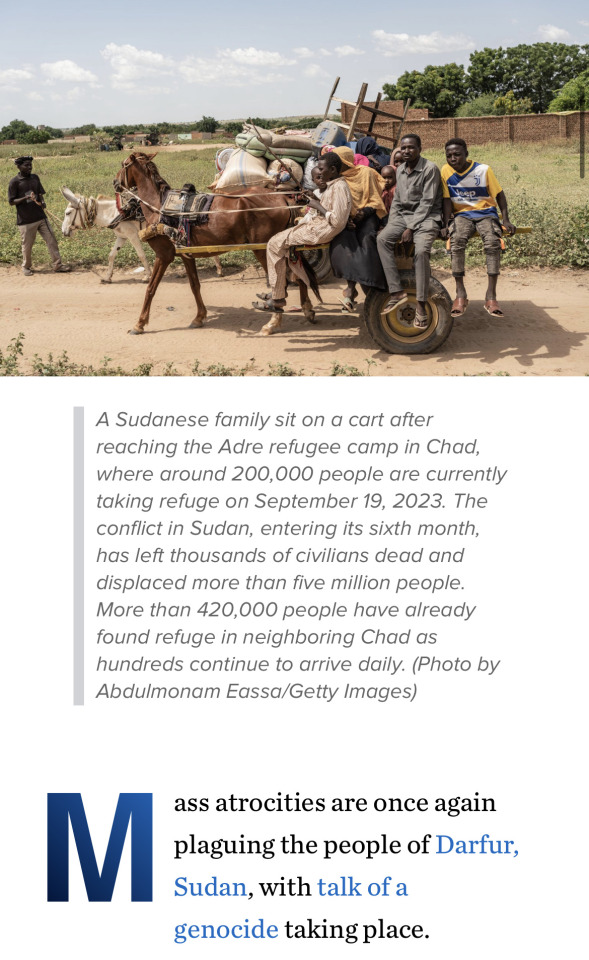
CNN:
Hundreds of families gathered in the West Darfur capital of El Geneina on June 15, plotting their escape from what had become a hellscape of blown-out buildings scrawled with racist graffiti and streets strewn with corpses. The state governor had just been executed and mutilated by Arab militia groups, leaving civilians with no choice but to flee.
What followed was a gruesome massacre, eyewitnesses said, believed to be one of the most violent incidents in the genocide-scarred Sudanese region’s history. The powerful paramilitary Rapid Support Forces and its allied militias hunted down non-Arab people in various parts of the city and surrounding desert region, leaving hundreds dead as they ran for their lives…
…residents set off en masse from southern El Geneina, many trying to reach the nearby Sudanese military headquarters where they thought they might find safety. But they said they were quickly thwarted by RSF attacks. Some were summarily executed in the streets, survivors said. Others died in a mass drowning incident, shot at as they attempted to cross a river. Many of those who managed to make it out were ambushed near the border with Chad, forced to sit in the sand before being told to run to safety as they were sprayed with bullets.
“More than 1,000 people were killed on June 15. I was collecting bodies on that day. I collected a huge number,” one local humanitarian worker, who asked not to be named for security reasons, told CNN. He said the dead were buried in five different mass graves in and around the city.
Conflict erupted between the RSF and the Sudanese army in April. Since then, more than one million people have fled to neighboring countries, according to estimates from the International Organization for Migration.
Now, a telecommunications blackout and the flight of international aid groups have all but cut off Darfur from the outside world. But news of the June 15 massacre began trickling out of the region from refugees who escaped to Chad. The evidence uncovered by CNN suggests that, behind a curtain of secrecy, the RSF and its allies are waging an indiscriminate campaign of widespread killings and sexual violence unlike anything the region has seen in decades.
The RSF’s official spokesperson told CNN that it “categorically” denied the allegations.
“To say you were Masalit was a death sentence,” said Jamal Khamiss, a human rights lawyer, referring to his non-Arab tribe, one of the biggest in Darfur. Khamiss was among those who said that they fled from El Geneina to Chad, surviving a series of RSF and allied militia positions by concealing his ethnicity.
The United Nations raised the alarm in June over ethnic targeting and killing of people from the Masalit community in El Geneina, after reports of summary executions and “persistent hate speech,” including calls to kill or expel them.
The vast majority of those who managed to make it out of El Geneina alive sought refuge in the Chadian border town of Adre, about 22 miles (35 kilometers) away from the city.
On June 15, the town received the highest number of migrants in a single day, along with the highest number of casualties — 261 — since the Sudan conflict broke out, according to Doctors Without Borders, widely known by its French name, Medecins Sans Frontieres (MSF), which runs the only hospital in Adre. The number of wounded people that arrived at the hospital was even higher the next day: 387.
“The last time we recorded the death toll in Geneina it was 884,” one local humanitarian worker from El Geneina, who works for a Western non-profit organization, told CNN. “That was June 9. After June 9, it was a different story. The dead became uncountable.”
Action Against Hunger is accepting donations to provide health, sanitation and nutrition services to Sudanese refugees in Chad.
2K notes
·
View notes
Text
Brazil is considered to have the worst levels of child sex trafficking after Thailand, with an estimated 250,000 children involved. This gets worse during holidays when foreign men visit to the country, such as the Rio de Janeiro Carnival.
This type of statistics always makes me think: to what level is this violence avoidable? Everywhere we go we see men doing this, no matter where they are from, their economic background or ethnicity. Men explore women inside their house, in their city, in their homeland and in foreign countries.
I firmly believe that no woman should trust her husband, brother, son or father completely, because we can never be sure about what they’re doing in secret. We can always notice too how usually men don’t hide this from other men. And this makes me question: how can we ever be safe if we share homes with them?
#radblr#radical feminist safe#radical feminists please touch#radfemblr#radical feminists please interact#radfeminism#trans exclusionary radical feminist#radical feminst#radical feminists do touch#radical feminist community#radical feminism#women liberation#women’s rights#male violence#violence against women#radical feminists do interact#womens liberation
366 notes
·
View notes
Text
Considering the blissful ignorance with which Armenia is treated by the foreign press, I’ve taken it upon myself to keep you (those who care) updated on what needs to be known.
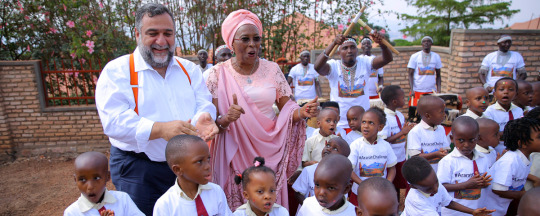
BACKGROUND
Following years of violations of ceasefire and intimidation against Armenian civilians, Azeri military forces used massive force in September 2020 to invade and occupy two-thirds of Nagorno-Karabakh. In September 2023, Azeri military forces took over the remaining territory, contradicting previously agreed-to negotiations and statements (OSCE peace negotiations, trilateral statements 2020,2021).
While an ethnic cleansing was taking place, the Azeri government arrested eight former members of the Republic’s government and advocates for the self-determination of Artsakh. Those detained include Ruben Vardanyan, an Armenian businessman and philanthropist who served as the State Minister of the Artsakh government.
Mr. Vardanyan and the seven others join over 50 Armenians arrested during the conflict, some of whom have been held for years by Azerbaijan. The negligible information on the health and well-being of these prisoners is deeply concerning.
Ruben Vardanyan
In addition to being the State Minister of the Artsakh government, Ruben Vardanyan is an influential Armenian philanthropist who in 2024 was nominated for Nobel Peace Prize for the creation and support for around five dozen new and unprecedented educational, charitable, scientific and humanitarian structures not only in Armenia, but also in a number of other countries.
Mr. Vardanyan has been charged with financing terrorism, although the legal situation for him and the others remains unclear and lacks transparency. The charges levied against him are considered completely unsubstantiated and are seen as an act of political retribution.
For this reason, it appears Azerbaijan is holding him as a political prisoner, hindering his ongoing projects and suppressing a voice advocating for progressive and positive change.
“We are gravely concerned about my father’s deteriorating health, though we are not surprised by his bravery," said David Vardanyan, one of Mr. Vardanyan's sons. "Despite our initial relief, my father’s conditions are only worsening. The world has shown Azerbaijan that it is watching the fate of the Armenian prisoners, including my father, and from our family I want to thank everyone for their support at this difficult time. I hope that this growing international attention may lead to his release in the nearest future. We urge the international community to further increase the pressure on Azerbaijan to ensure that at least his trial takes place in May 2024 with international observers.” The State Department’s annual Human Rights Report, released on April 23, corroborated the unjust conditions that Mr. Vardanyan and other political prisoners and detainees face in Azerbaijan. The report on Azerbaijan estimated that the country held approximately 254 political prisoners and detainees as of December 2023. The judiciary was also described as largely corrupt, inefficient, and lacking independence. According to the report, defendants in Azerbaijan were often “denied the right to a presumption of innocence; a fair, timely, and public trial; to communicate with an attorney of their choice; to have adequate time and facilities to prepare a defense; to confront witnesses and present one’s own witnesses and evidence; and not be compelled to testify or confess guilt.”
Today Azerbaijan has extended the detention period of Ruben Vardanyan by 5 months.
HELP FREE RUBEN VARDANYAN Join the international community in calling for Ruben Vardanyan’s release alongside the other Armenians being held in Baku, Azerbaijan.
TAKE ACTION by adding your name to THE LIST of supporters.
#break the chain of ignorance#world news#armenia#armenian history#artsakh is armenia#ruben vardanyan#call for peace#world history#nobel prize#nobel peace prize#reporting from yerevan
515 notes
·
View notes
Text

Via NasAlSudan
Learn about the Sudanese revolution, the significance of December 19, and a legacy of resistance and resilience.
Join our call to action today and everyday during Sudan Action Week.
December 19 2023

Transcript:
Breaking it down
What is the Sudanese Revolution?
The Sudanese Revolution refers to the popular uprising in Sudan that began on December 19, 2018 and eventually deposed 30-year dictator of Sudan, Omar al-Bashir, on April 11 of 2019.
How did the Revolution begin?
Protests first began in Atbara, a city with historical significance to the labor movement in Sudan, in response to the rising costs of basic supplies such as bread and fuel.
Protestors set fire to the national party headquarters, and the news of their revolt quickly spread, inspiring protestors first in other cities, and then in the capital of Khartoum itself.
Online, the caption #TasgutBas, translating to #JustFall, grew in popularity and helped connect the diaspora to those in Sudan.
Was it really just bread?
No. The rising cost of bread in developing nations is an indicator of how badly the economy is strained, to the point where it impacts members of every social class.
At this point in time in Sudan, subsidies on essential goods had been rolled back, funding for social and state services such as healthcare and education was nearly nonexistent, and it is estimated that nearly 90% of economic activity took place in the informal sector, all while the military budget continually increased.
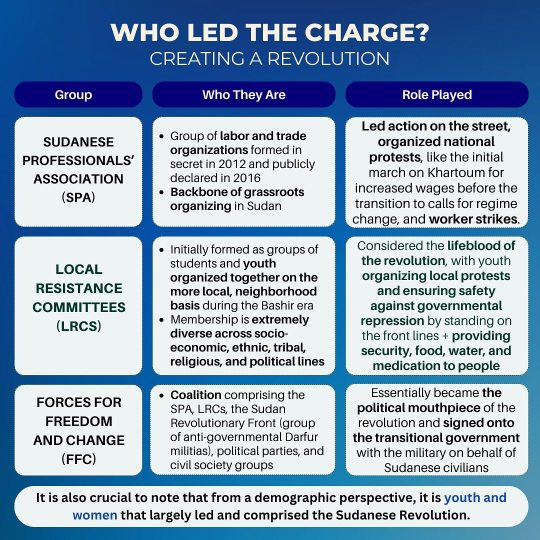
Transcript:
Who led the charge? Creating a revolution
Group: Sudanese Professional's association (SPA)
Who they are:
Group of labor and trade organizations formed in secret in 2012 and publicly declared in 2016
Backbone of grassroots organizing in Sudan
Role played:
Led action on the street, organized national protests, like the initial march on Khartoum for increased wages before the transition to calls for regime change, and worker strikes.
Group: Local Resistance Committees (LRCS)
Who they are:
Initially formed as groups of students and youth organized together on the more local, neighbourhood basis during the Bashir era
Membership is extremely diverse across socio-economic, ethnic, tribal, religious, and political lines
Role played:
Considered the lifeblood of the revolution, with youth organizing local protests and ensuring safety against governmental repression by standing on the front lines + providing security, food, water, and medication to people
Group: Forces for freedom and change (FFC)
Who they are:
Coalition comprising the SPA, LRCS, the Sudan Revolutionary Front (group of anti-governmental Darfur militias), political parties, and civil society groups
Role played:
Essentially became the political mouthpiece of the revolution and signed onto the transitional government with the military on behalf of Sudanese civilians
It is also crucial to note that from a demographic perspective, it is youth and women that largely led and comprised the Sudanese Revolution.
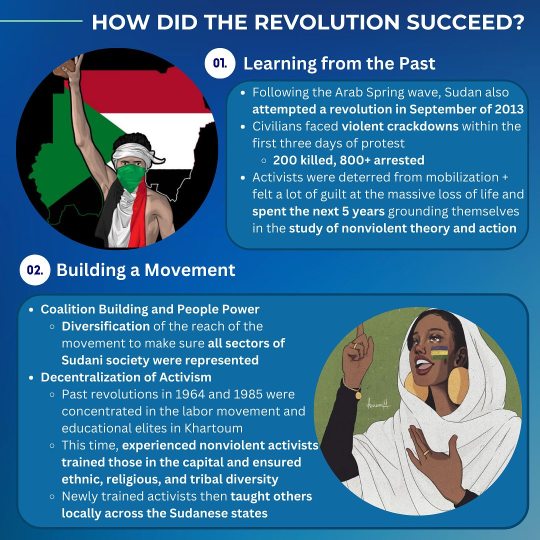
Trabscript:
How did the revolution succeed?
01. Learning from the Past
Following the Arab Spring wave, Sudan also attempted a revolution in September of 2013
Civilians faced violent crackdowns within the first three days of protest. 200 killed, 800+ arrested
Activists were deterred from mobilization + felt a lot of guilt at the massive loss of life and spent the next 5 years grounding themselves in the study of nonviolent theory and action
02. Building a Movement
Coalition Building and People Power
Diversification of the reach of the movement to make sure all sectors of Sudani society were represented
Decentralization of Activism
Past revolutions in 1964 and 1985 were concentrated in the labor movement and educational elites in Khartoum
This time, experienced nonviolent activists trained those in the capital and ensured ethnic, religious, and tribal diversity
Newly trained activists then taught others locally across the Sudanese states
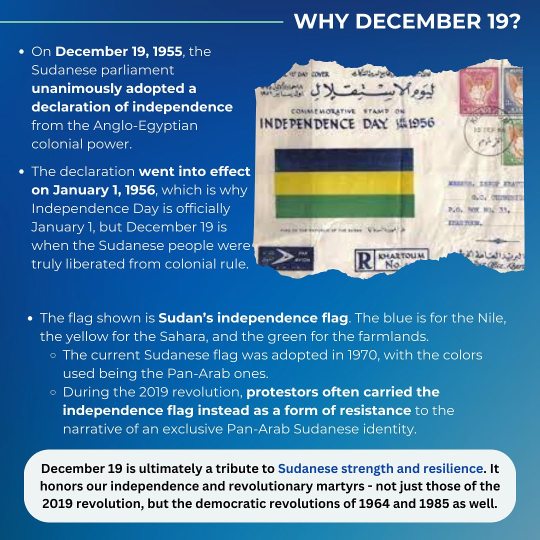
Transcript:
Why december 19?
On December 19, 1955, the Sudanese parliament unanimously adopted a declaration of independence from the Anglo-Egyptian colonial power.
The declaration went into effect on January 1, 1956, which is why Independence Day is officially January 1, but December 19 is when the Sudanese people were truly liberated from colonial rule.
The flag shown is Sudan's independence flag. The blue is for the Nile, the yellow for the Sahara, and the green for the farmlands.
The current Sudanese flag was adopted in 1970, with the colors used being the Pan-Arab ones.
During the 2019 revolution, protestors often carried the independence flag instead as a form of resistance to the narrative of an exclusive Pan-Arab Sudanese identity.
December 19 is ultimately a tribute to Sudanese strength and resilience. It honors our independence and revolutionary martyrs - not just those of the 2019 revolution, but the democratic revolutions of 1964 and 1985 as well.

Transcript:
Why is the revolution ongoing?
The goal was never just the fall of a dictator. The goal was, and is, to build a better Sudan, one free from military rule. One with equal opportunities for everyone, with economic prosperity and safety and security - the key principles of freedom, peace, and justice that the revolution called for.
Today, though, before we rebuild Sudan, before we free it from foreign interests and military rule and sectarianism, we need to save it. Each day that passes by with war waging on is one where more civilians are killed. More people are displaced. More women are raped. More children go hungry. To live in the conflict zones in Sudan right now - whether that be Khartoum, Darfur, Kordofan, or now, Al Gezira, is to be trapped in a never-ending nightmare, a fight for survival. And to live elsewhere in Sudan is to wonder whether you're next.
Sudan Action Week calls on you to educate yourself and others about Sudan, and then to help the Sudanese people save it, because we can no longer do it alone.
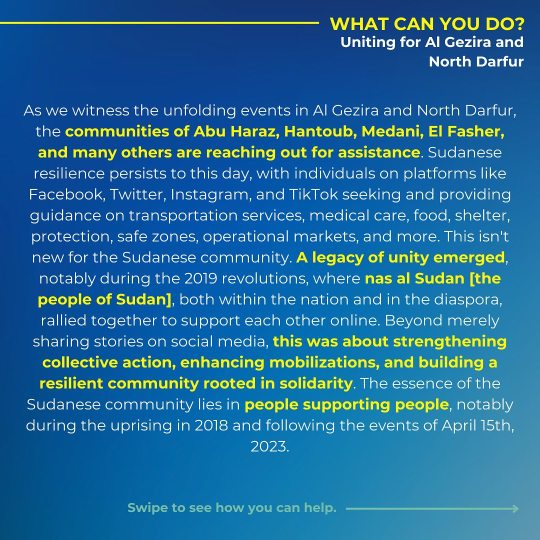
Transcript:
What can you do? Uniting for Al Gezira and North Darfur
As we witness the unfolding events in Al Gezira and North Darfur, the communities of Abu Haraz, Hantoub, Medani, El Fasher, and many others are reaching out for assistance. Sudanese resilience persists to this day, with individuals on platforms like Facebook, Twitter, Instagram, and TikTok seeking and providing guidance on transportation services, medical care, food, shelter, protection, safe zones, operational markets, and more. This isn't new for the Sudanese community. A legacy of unity emerged, notably during the 2019 revolutions, where nas al Sudan [the people of Sudan], both within the nation and in the diaspora, rallied together to support each other online. Beyond merely sharing stories on social media, this was about strengthening collective action, enhancing mobilizations, and building a resilient community rooted in solidarity. The essence of the Sudanese community lies in people supporting people, notably during the uprising in 2018 and following the events of April 15th, 2023
Swipe to see how you can help.
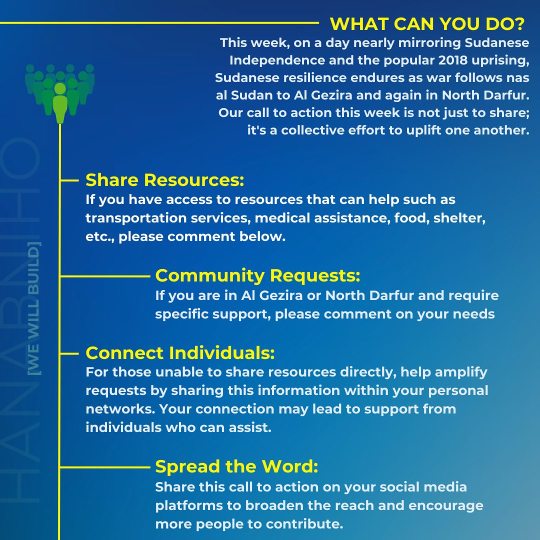
Transcript:
What can you do?
This week, on a day nearly mirroring Sudanese Independence and the popular 2018 uprising, Sudanese resilience endures as war follows nas al Sudan to Al Gezira and again in North Darfur. Our call to action this week is not just to share; it's a collective effort to uplift one another.
Share Resources:
If you have access to resources that can help such as transportation services, medical assistance, food, shelter, etc., please comment below.
Community Requests:
If you are in Al Gezira or North Darfur and require specific support, please comment on your needs
Connect Individuals:
For those unable to share resources directly, help amplify requests by sharing this information within your personal networks. Your connection may lead to support from individuals who can assist.
Spread the Word:
Share this call to action on your social media platforms to broaden the reach and encourage more people to contribute.
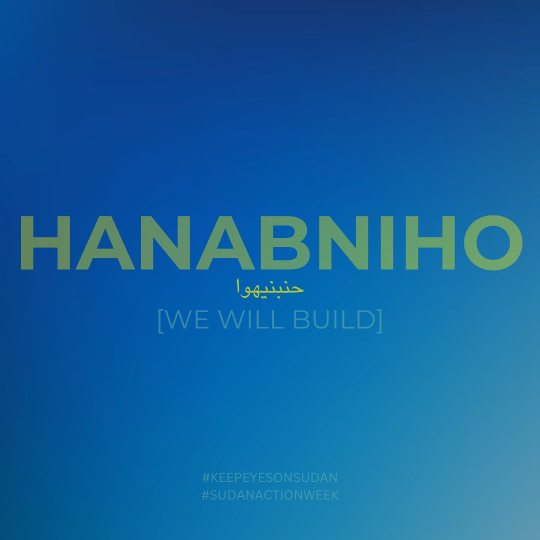
Transcript:
Hanabniho
حنبنيهوا
[We will rebuild]
#keepEyesOnSudan
#SudanActionWeek
924 notes
·
View notes
Text
Gaza is home to one of the oldest Christian communities in the world, dating back to the first century, and the third oldest church in the world. Despite constant threats to survival, the community has persisted for two millennia. But now, extinction may be unavoidable this time due to Israel’s indiscriminate war and imposed famine, which has killed more than 32,000 Palestinians in Gaza. There are only about 800 Christians left in Gaza. The Western world, which often champions the rights of the religious minorities in the region, is eerily silent. Since the beginning of the Israeli attack on Gaza, the small Christian minority has been impacted in the same way as their fellow Palestinians. Most Christians have historically lived in Gaza City, an area, like other parts of north Gaza, that was systematically targeted at the very beginning of the war and is currently suffering from a lack of access to food and aid. Although there is no reliable estimate on the number of Christian homes fully or partially destroyed, the Christians sheltering at the churches indicate to me that Israel has destroyed some 80% of their houses and killed more than 3% of the population.
[...]
In the West, people often ask me why the number of Christians in the Middle East is decreasing and why we are leaving. Usually, they were waiting for us to blame the Muslims for their “persecution of Christians.” But this explanation is not only an oversimplification but also incorrect. No one can deny the occurrence of sectarian discrimination, in some cases, by the Muslim majority against the Christians minorities, but it is often not the primary cause of the mass exodus of indigenous Christians from the land. Instead, the mass exodus of Christians is caused by scenarios similar to Gaza today: the brutality of wars that make it harder for Christians to survive. In 1948, Palestinian Christians, like Muslims, were ethnically cleansed from Mandatory Palestine and never allowed back; this was the biggest hit for the number of Christians in Palestine.
Other Western-backed wars and the “War on Terror” have also significantly contributed to the exodus of Christians in the Middle East. Take, for example, Iraq, which had over 1.5 million Christians before the American invasion in 2003. The invasion and years of war harmed the Christians like Muslims, and it also created the conditions for the emergence of radical groups like the Islamic State that see religious minorities as a prime target. Today, Iraq has just 150,000 Christians left.
476 notes
·
View notes
Text
queer palestinian short film: "houria"
queer short cuts is a biweekly newsletter where i share queer & trans short film recommendations. i’m featuring some of my favorite films on tumblr because why not

palestine | 7 minutes | 2010 | experimental short film audio in arabic; english subtitles embedded
houria | حـ(و)ـرية, an experimental film directed by raafat hattab, intercuts between a violinist (boodi el esawi) playing on a beach at manshiye who is joined unexpectedly by a mermaid (played by raafat hattab himself), a person getting their chest tattooed, and an interview with hattab’s grandmother, yousra, talking about her parents’ flight from their home in jamaseen al-garbi when she was a baby, during the 1948 nakba (“catastrophe”), during which thousands of palestinians were killed and an estimated 700,000 were displaced because of Israeli ethnic cleansing. The gender fluidity of hattab’s mermaid, the permanence of the tattoo, and the impermanence of palestinian life and homeland in yousra’s story come together to illustrate the paradoxes and grief of dislocation that palestinians face daily. - deepa's full review, including content notes at the end
watch on youtube, and learn more about creator raafat hattab, who is a queer palestinian interdisciplinary artist based in tel aviv, at his website
#queer short cuts#free palestine#queer film#short film#palestine#palestinian film#palestinian queer film#experimental film#raafat hattab#boodi el esawi#undescribed#knowing me knowing queue
818 notes
·
View notes
Text
Just a reminder: intent is much, much more important to genocide than the amount of people dying. simply put, the amount of dead civilians isn't what makes a genocide a genocide.
for example, up to 33k bosnians are estimated to have died because of the bosnian genocide. in contrast, the estimated amount of japanese civilians dead during WWII is between 330k and 900k. yet most (serious) people wouldn't ever consider that there was a genocide against the japanese people. why? well, no government wanted to, planned or carried out systematic attacks with the intent of erasing, in whole or in part, the japanese people. yet, however, it is fairly easy to prove that the serbs wanted the bosnians gone and acted accordingly. You can even fullfill the material criteria for the Genocide Convention (ie killing people, or causing body or mental harm to a population) to a certain extent but if the intent behind those actions isn't to destroy a national/ethnic/etc group, then it's not genocide, the fullfilment of the material elements themselves aren't proof that there's a genocide without fullfilment of the mental element.
This isn't to overlook civilian deaths, but truth is, in modern warfare, civilians ARE gonna die, and that sucks massively, but we have a a whole branch of international law that help mitigate a lot of civilian deaths and allow for criminals to be held accountable for violation of civilian rights and livs, without having to erroneously call every single conflict where people die a genocide.
Similarly, it may be true that a lot more people are dying in the Israel-Gaza war than in the 7/10 attacks, but why did Hamas attack Israel in the first place? Why has Israel been attacked fairly frequently since it's independence? Because they want to completely erase Israel as a whole and expel (and kill, or best case scenario, convert) the jewish people out of the Middle East. This is very easy to prove, read Hamas founding charter and literally any history book that talks about wars against Israel or the expulsion of Jews from several ME countries. It's what the whole "from the river to the sea" slogan is about. It's also the very reason Israel needs to exist. But meanwhile, there's little to nothing that points out Israel wants to wipe out Palestinians as a group: 20% of their citizens are Palestinians who enjoy the same rights as Jewish citizens of Israel and aren't targeted, even Palestinians of the West Bank aren't usually targeted in a way that would even imply the IDF wants to erase them as a group, and even considering the Gaza campaign, its objective is to erradicate Hamas, not Palestinians, and nothing in Israel's policy outwardly implicates they want to erradicate all Gazans. Palestine, and especially Gaza, has massive population growth, which wouldn't make sense if there was a genocide campaign against them. This isn't to say the IDF is doing everything perfectly or that there aren't war crimes being commited. But war crimes don't mean genocide.
Calling what's happening in Gaza genocide is antisemitic, because not only are we applying different standards to Israel than we do any other country, we are also saying that Jewish people defending themselves is, inherently, a crime, one of the worst crimes defined at that. But it's also harmful to palestinians, because claiming that Israel's war against Hamas is a war against Palestinians equates Palestinians (many of whom just want to live regular lives, not war) with terrorists (who also target them, by the way), which seems islamophobic as hell if i'm being honest. it is also insensitive and damaging to every group that has been the victim of genocide, and every group which might be a victim of a genocide in the future, because how you're twisting the definition of the word to mean whatever you want it to mean. If everything is a genocide, nothing is.
#sincerely an IR major tired of people not knowing what words mean#i stand with israel#i stand with palestine#israel#israel gaza#palestine#hamas#israel palestine#genocide#hamas is isis#free palestine#free palestine from hamas#antisemitism
456 notes
·
View notes
Text
ok, im making this a new post because im pretty tired of people saying "white jews" are "from europe after the holocaust." um no they are not.
I’m an American Ashkenazi Jew and the American Jewish population is much much older than immigrants from the holocaust. My father’s grandmothers family came from Eastern Europe in the 1850s and my father’s grandfather’s side came 1. some few generations before the civil war and 2. At least the 1840s for unknown reasons because we’ve been here so long my family forgot.
My grandmother personally started a business in her basement in the 20s and 30s to get European Jews work visas in the US so they could escape during and after the holocaust. Huge socialist.
Jews were arrested for union drives in 1909 America waaay before the holocaust. Jews were excepted from prohibition in America because of wine at Shabbat. That whole religious freedom thing in America? It’s always been attractive to Jews fleeing Russia and Europe and the Middle East since the us rolled the constitution out in 1776.
So, like, most Zionist Jews (because American has the second largest Jewish population in the world) are Americans who were here for hundreds of years.
Very few Jews escaped the holocaust. Very few Jews escaped Europe. very few living jews are European or "Escaped" the holocaust at all if you just look at the numbers. Jews only escaped Middle Eastern ethnic cleansing because of Israel. That was the entire reason for Israel. A place to escape the 70 year cycle of Jewish genocides.
6 million isn’t just a big number. It’s an indicator that there are very few “white European” Jews who escaped. When you say European Jews who escaped the holocaust, you are talking a very small number of people. It’s estimated at 240,000 “white European Jews” lived compared to 6 million who were killed.
i'll repeat that. 240,000 European people (340.000 escaped germany but 100,000 stayed in europe and were recaptured and sent to be killed leaving just the 240,000) lived. 6 MILLION DIED.
240,000 lived and 6 MILLION WERE KILLED. IN EUROPE. THE PLACE WHO IS CURRENTLY ELECTING SIMILAR GOVERNMENTS TO THE 1930S.
328 notes
·
View notes
Note
Actually bathrooms shouldn't be gendered at all that's half the problem.
In communities that lack access to single-sex bathrooms, you witness an increase in the rate of sexual violence, physical health issues like incontinence, and mental health issues like PTSD. If women's health and safety aren't a problem to you, then by all means continue insisting that there's no need to provide them, but you should know these issues disproportionately affect poor women, disabled women, young women, and women from ethnically, linguistically, and racially diverse backgrounds (e.g. bathrooms in northern India are particularly unsafe for women).
I'll leave you with a quote from a book I read recently - Invisible Women, by Caroline Criado Perez:
According to the UN, one in three women lack access to safe toilets, and WaterAid reports that girls and women collectively spend 97 billion hours a year finding a safe space to relieve themselves [which affects their productivity, as women are more likely to be engaged in the informal economy, and their safety]. Local governments that fail to provide public toilets may believe that they are cutting costs, but a 2015 Yale study suggests that this is a false economy. [They linked] the ‘risk of sexual assault to the number of sanitation facilities and the time a woman must spend walking to a toilet, and calculated the tangible costs (lost earnings, medical, court, and prison expenses) and intangible costs (pain and suffering, risk of homicide) [against] the cost of installing and maintaining public toilets … [they found public toilets could save one town $5 million better off, which is a conservative estimate, as it doesn’t include the various health benefits saved from women having more regular and more private bowel movements (e.g. chronic constipation, cholera)]. Health problems arising from a lack of public sanitary provision are not restricted to low-income countries. Canadian and British studies have revealed that referrals for urinary-tract infection, problems with distended bladders, and a range of other uro-gynaeloogical problems have increased proportionately to [toilet inaccessibility]. Urban planning that fails to account for women’s risk of being sexually assaulted is a clear violation of women’s equal right to public spaces – and inadequate sanitary provision is only one of the many ways planners exclude women with this kind of gender-insensitive design. ... For women who try to escape from war and disaster, the gender-neutral nightmare often continues in the refugee camps of the world … [although] international guidelines state that toilets in refugee camps should be sex-segregated, marked, and lockable, [sic] these requirements are often not enforced [and] research by the Women’s Refugee Commission has found that women and girls in accommodation centres in Germany and Sweden are vulnerable to rape, assault, and other violence…
248 notes
·
View notes